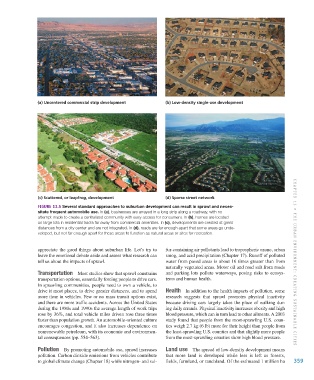Page 360 - Environment: The Science Behind the Stories
P. 360
(a) Uncentered commercial strip development (b) Low-density single-use development
(c) Scattered, or leapfrog, development (d) Sparse street network
FIGURE 13.5 Several standard approaches to suburban development can result in sprawl and neces-
sitate frequent automobile use. In (a), businesses are arrayed in a long strip along a roadway, with no
attempt made to create a centralized community with easy access for consumers. In (b), homes are located
on large lots in residential tracts far away from commercial amenities. In (c), developments are created at great
distances from a city center and are not integrated. In (d), roads are far enough apart that some areas go unde-
veloped, but not far enough apart for these areas to function as natural areas or sites for recreation.
appreciate the good things about suburban life. Let’s try to fur-containing air pollutants lead to tropospheric ozone, urban
leave the emotional debate aside and assess what research can smog, and acid precipitation (Chapter 17). Runoff of polluted
tell us about the impacts of sprawl. water from paved areas is about 16 times greater than from CHAPTER 13 • THE URB AN ENVIR ONMENT : CREATING SUSTAIN ABLE CITIES
naturally vegetated areas. Motor oil and road salt from roads
Transportation Most studies show that sprawl constrains and parking lots pollute waterways, posing risks to ecosys-
transportation options, essentially forcing people to drive cars. tems and human health.
In sprawling communities, people need to own a vehicle, to
drive it most places, to drive greater distances, and to spend Health In addition to the health impacts of pollution, some
more time in vehicles. Few or no mass transit options exist, research suggests that sprawl promotes physical inactivity
and there are more traffic accidents. Across the United States because driving cars largely takes the place of walking dur-
during the 1980s and 1990s the average length of work trips ing daily errands. Physical inactivity increases obesity and high
rose by 36%, and total vehicle miles driven rose three times blood pressure, which can in turn lead to other ailments. A 2003
faster than population growth. An automobile-oriented culture study found that people from the most-sprawling U.S. coun-
encourages congestion, and it also increases dependence on ties weigh 2.7 kg (6 lb) more for their height than people from
nonrenewable petroleum, with its economic and environmen- the least-sprawling U.S. counties and that slightly more people
tal consequences (pp. 554–563). from the most-sprawling counties show high blood pressure.
Pollution By promoting automobile use, sprawl increases Land use The spread of low-density development means
pollution. Carbon dioxide emissions from vehicles contribute that more land is developed while less is left as forests,
to global climate change (Chapter 18) while nitrogen- and sul- fields, farmland, or ranchland. Of the estimated 1 million ha 359
M13_WITH7428_05_SE_C13.indd 359 12/12/14 4:59 PM

